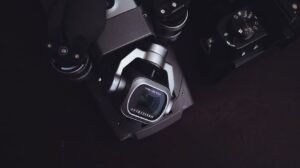Film to Digital
In the world of photography, the transition from film to digital has revolutionized the way we capture and store images. Film photography, once the dominant medium, has progressively been replaced by digital photography due to its numerous advantages. If you’re interested in understanding the transition from film to digital, this article will provide you with an overview of the key differences, benefits, and challenges of each medium.
Key Takeaways:
- Film photography and digital photography have distinct differences in the way images are captured and stored.
- Digital photography offers greater convenience, flexibility, and immediate feedback compared to film photography.
- The transition from film to digital has democratized photography and opened up new creative possibilities.
The first significant difference between film and digital photography is the way images are captured. Film cameras use light-sensitive film to record the image projected through the lens. On the other hand, digital cameras use an electronic sensor to capture light and convert it into digital data. This fundamental distinction sets the stage for the advantages and limitations of both mediums. *The process of capturing light with film produces a unique aesthetic that film enthusiasts admire, characterized by rich tones and a distinct grain pattern.*
Digital photography offers several advantages over film photography. First and foremost, digital cameras allow instant previewing of images on a screen, enabling photographers to make adjustments on the spot. Additionally, digital images can be quickly and easily shared online with a global audience, eliminating the need for physical prints. *The ability to instantly preview and adjust settings has made digital photography highly accessible and user-friendly to beginners.*
One of the most significant benefits of digital photography is the ability to post-process and edit images. Digital files offer greater flexibility to manipulate various parameters such as exposure, white balance, and color grading, providing photographers with extensive creative control. Furthermore, digital images can be easily stored, duplicated, and backed up without degradation in quality. *The freedom to experiment with different editing techniques has allowed photographers to push the boundaries of their creativity.*
Comparison between Film and Digital Photography:
| Aspect | Film Photography | Digital Photography |
|---|---|---|
| Capture Medium | Film roll | Electronic sensor |
| Previewing | No immediate preview | Instant preview on screen |
| Editing | Manipulation limited | Extensive post-processing capabilities |
Despite the advantages, the transition to digital photography has raised some challenges. The initial cost of entry into the digital realm can be prohibitive, with high-quality cameras and lenses often carrying hefty price tags. Moreover, the rapid advancement of digital technology can lead to equipment becoming outdated, necessitating frequent upgrades. *Learning to master the multitude of features and settings in digital cameras can also pose a learning curve for those accustomed to the simplicity of film cameras.*
Comparison between Film and Digital Photography:
| Aspect | Film Photography | Digital Photography |
|---|---|---|
| Cost | Low upfront cost, ongoing expenses for film and processing | Higher upfront cost, minimal expenses for digital storage |
| Outdated Technology | No technological obsolescence | Rapidly advancing technology requires upgrades |
| Learning Curve | Relatively simple operation | Complex features and settings to navigate |
Despite its challenges, the transition from film to digital has democratized photography. The accessibility and affordability of digital cameras have opened up opportunities for aspiring photographers to experiment and learn without the inherent costs and delays associated with film. Furthermore, the ability to share images instantly online has created a global community where photographers can connect and exchange ideas. *Digital photography has empowered individuals to express their creativity and perspective on a larger scale.*
As technology continues to advance, it’s evident that digital photography has become the primary medium for capturing and sharing images. The transition from film to digital has not only changed the way we take photographs but also revolutionized the world of photography as a whole. Whether you are an avid film lover or have fully embraced the world of digital, both mediums provide unique opportunities for creative expression.

Common Misconceptions
Resolution
One common misconception people have about film to digital conversion is that digital images always have higher resolution compared to film. However, it is important to note that high-quality film can actually capture an incredible amount of detail, often surpassing what digital cameras can achieve.
- Film possesses a greater dynamic range than digital sensors.
- Scanning a film at a higher resolution can often yield impressive results.
- Film grain can add aesthetic appeal to the final digital image.
Quality
Another misconception is that converting film to digital automatically improves the overall quality of the image. While the digital format has numerous benefits, it is essential to understand that the conversion process can introduce various factors that may impact image quality.
- The condition of the film and scanner may affect the final output.
- Poorly maintained film negatives may result in artifacts or loss of detail.
- Choosing the right scanning method and settings is crucial for optimal results.
Authenticity
Many people believe that digital images lack the authenticity and character of film photographs. While film has a unique aesthetic and charm, it is a misconception to assume that digital images cannot replicate or even enhance these qualities.
- Various post-processing techniques can mimic the look and feel of film.
- Digital editing can provide greater flexibility and control over the final result.
- Prints made from high-quality digital files can rival traditional darkroom prints.
Cost
It is commonly believed that transitioning from film to digital photography is more expensive. While the initial investment in a digital camera and equipment can be significant, over time, digital photography can be more cost-effective.
- Eliminating the cost of film and developing saves money in the long run.
- Digital files can be easily duplicated and shared without additional cost.
- Editing and printing only the best images reduces unnecessary expenses.
Skills and Creativity
One common misconception is that digital photography requires fewer skills and is less creative compared to film photography. However, both mediums offer unique opportunities for artistic expression and technical mastery.
- Digital cameras provide instant feedback, allowing photographers to experiment and learn quickly.
- Advanced editing software enables creative manipulation and exploration of different styles.
- Mastering digital photography requires understanding exposure, composition, and storytelling, just like with film.

The Evolution of Film and Digital Photography
Film and digital photography have both played significant roles in capturing and preserving precious moments throughout history. This article explores the transition from film to digital photography, highlighting key points, data, and other elements to showcase the fascinating journey.
The Birth of Film Photography
Table depicting the key milestones in the development of film photography, from the first known photograph to the creation of color film.
| Year | Milestone |
|---|---|
| 1826 | First known photograph taken by Joseph Nicéphore Niépce |
| 1888 | George Eastman introduces the Kodak camera, leading to the popularity of snapshot photography |
| 1936 | Eastman Kodak releases the first color film using the “Kodachrome” process |
The Rise of Digital Photography
This table showcases advancements in digital photography, from the introduction of the first digital camera to the proliferation of smartphones with high-quality cameras.
| Year | Milestone |
|---|---|
| 1975 | Steven Sasson invents the first digital camera at Eastman Kodak |
| 1991 | Kodak releases the first consumer digital camera, the Kodak DCS-100 |
| 2000 | Nokia introduces the Nokia 7650, the first smartphone with an integrated camera |
Film vs. Digital: Image Quality
This table compares the advantages and disadvantages of film and digital photography regarding image quality.
| Aspect | Film | Digital |
|---|---|---|
| Resolution | Varies; dependent on film type and technique | Increasingly high resolutions; up to several hundred megapixels |
| Color Accuracy | Vibrant and rich colors | Color reproduction can be easily adjusted and manipulated |
| Noise | Minimal noise in low ISO films | Digital noise is prevalent, especially in low-light conditions |
Economic Impact of Digital Photography
This table highlights the economic consequences of the growing popularity of digital photography, including revenue shifts and job market changes.
| Statistic | Impact |
|---|---|
| Global film sales (2000) | $12.5 billion |
| Global film sales (2019) | $200 million |
| Photography job growth (2002-2022) | -3% |
The Digital Revolution: Innovations in Photography
This table showcases the technological advancements in digital photography, leading to improved convenience, creativity, and accessibility.
| Technology | Description |
|---|---|
| Live View | Allows photographers to preview the image on an LCD screen before capturing |
| Face Detection | Automatically identifies faces in the frame for accurate focusing and exposure |
| Wireless Connectivity | Enables instant photo sharing and remote camera control |
Film Photography Reemergence
This table presents examples of film photography‘s resurgence in recent years as a niche and artistic medium.
| Photographer | Notable Work |
|---|---|
| Sally Mann | “Immediate Family” (1992): Controversial series capturing her children’s experiences |
| Robert Frank | “The Americans” (1958): Iconic documentation of American society |
| Annie Leibovitz | Renowned for her portraits of celebrities, captured on film |
The Future of Photography: Hybrid Approaches
This table displays examples of emerging hybrid approaches that bridge the gap between film and digital photography.
| Hybrid Approach | Description |
|---|---|
| Film Scanning | Digitizing film negatives or slides for archiving and post-processing flexibility |
| Instant Film Cameras | Marrying digital features with the nostalgic feel of instant film |
| Smartphone Film Scanners | Devices allowing the digitization of 35mm negatives using smartphone cameras |
Environmental Impact: Film vs. Digital
This table compares the environmental implications of film and digital photography, including considerations such as energy usage and waste.
| Aspect | Film | Digital |
|---|---|---|
| Energy Consumption | Lower energy demand during manufacturing | Higher energy consumption during production but lower for subsequent usage |
| Chemical Waste | Chemical disposal and development fluids contribute to pollution | Reduced chemical waste, though electronic waste is a concern |
| Storage Space | Negatives, prints, and physical albums require physical storage space | Digital files can be stored compactly on various media |
The Transition: Film to Digital
This table exemplifies the key stages and challenges photographers encountered during the transition from film to digital photography.
| Stage | Challenges |
|---|---|
| Equipment Adaptation | Photographers needed to invest in new digital cameras and related technology |
| Workflow Adjustment | Learning new post-processing techniques and digital file management |
| Preservation Dilemma | Addressing the longevity and accessibility of digital archives compared to physical prints |
Conclusion
Film and digital photography have witnessed remarkable progressions and transformations, each leaving its unique mark on the history of photography. From the birth of film photography to the rise of digital imaging, the industry has evolved to offer unprecedented image quality, convenience, and creative possibilities. The digital revolution disrupted traditional economic models and allowed new avenues for artistic expression. However, the resurgence of film photography demonstrates a continued appreciation for its distinct aesthetic and nostalgic appeal. As photography progresses, various hybrid approaches merge the best aspects of both film and digital mediums.
Frequently Asked Questions
Film to Digital
FAQs:
- Question 1:
- What is the process of converting film to digital?
- Question 2:
- Are there any benefits to converting film to digital?
- Question 3:
- Can any type of film be converted to digital?
- Question 4:
- How long does the film to digital conversion process take?
- Question 5:
- What happens to the original film after it is converted to digital?
- Question 6:
- How should I prepare my film for conversion?
- Question 7:
- Can film that has been damaged or deteriorated be converted to digital?
- Question 8:
- What format are the digital files provided in after film conversion?
- Question 9:
- Is film to digital conversion a permanent process?
- Question 10:
- Can I edit the digital files after film conversion?




